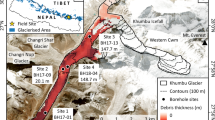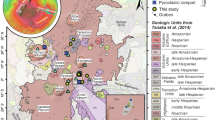Abstract
Images from the Mars Express HRSC (High-Resolution Stereo Camera) of debris aprons at the base of massifs in eastern Hellas reveal numerous concentrically ridged lobate and pitted features and related evidence of extremely ice-rich glacier-like viscous flow and sublimation. Together with new evidence for recent ice-rich rock glaciers at the base of the Olympus Mons scarp superposed on larger Late Amazonian debris-covered piedmont glaciers, we interpret these deposits as evidence for geologically recent and recurring glacial activity in tropical and mid-latitude regions of Mars during periods of increased spin-axis obliquity when polar ice was mobilized and redeposited in microenvironments at lower latitudes. The data indicate that abundant residual ice probably remains in these deposits and that these records of geologically recent climate changes are accessible to future automated and human surface exploration.
This is a preview of subscription content, access via your institution
Access options
Subscribe to this journal
Receive 51 print issues and online access
$199.00 per year
only $3.90 per issue
Buy this article
- Purchase on SpringerLink
- Instant access to full article PDF
Prices may be subject to local taxes which are calculated during checkout




Similar content being viewed by others
References
Grove, J. M. The Little Ice Age (Routledge, London, 1988)
Warren, C. R. Glaciers in the greenhouse. Geogr. Rev. 8, 2–7 (1995)
Mellon, M. T. & Jakosky, B. M. The distribution and behavior of Martian ground ice during past and present epochs. J. Geophys. Res. 100, 11781–11799 (1995)
Feldman, W. C. et al. Global distribution of neutrons from Mars: Results from Mars Odyssey. Science 297, 75–78 (2002)
Laskar, J. et al. Long term evolution and chaotic diffusion of the insolation quantities of Mars. Icarus 170, 343–364 (2004)
Richardson, M. I. & Wilson, R. J. Investigation of the nature and stability of the Martian seasonal water cycle with a general circulation model. J. Geophys. Res. 107, doi:10:1029/2001JE001536 (2002)
Mischna, M. et al. On the orbital forcing of Martian water and CO2 cycles: A general circulation model study with simplified volatile schemes. J. Geophys. Res. 108, doi:10.1029/2003JE002051 (2003)
Haberle, R. M. et al. Orbital change experiments with a Mars general circulation model. Icarus 161, 66–89 (2003)
Head, J. W. et al. Recent ice ages on Mars. Nature 426, 797–802 (2003)
Head, J. W. & Marchant, D. R. Cold-based mountain glaciers on Mars: Western Arsia Mons. Geology 31, 641–644 (2003)
Squyres, S. W. Martian fretted terrain—Flow of erosional debris. Icarus 34, 600–613 (1978)
Colaprete, A. & Jakosky, B. M. Ice flow and rock glaciers on Mars. J. Geophys. Res. 103, 5897–5909 (1998)
Mangold, N. & Allemand, P. Topographic analysis of features related to ice on Mars. Geophys. Res. Lett. 28, 407–410 (2001)
Mangold, N. et al. Experimental and theoretical deformation of ice-rock mixtures: Implications on rheology and ice content of Martian permafrost. Planet. Space Sci. 50, 385–401 (2002)
Baratoux, D. et al. Evidence of liquid water in recent debris avalanche on Mars. Geophys. Res. Lett. 29, doi:10.1029/2001GL014155 (2002)
Mangold, N. Geomorphic analysis of lobate debris aprons on Mars at Mars Orbiter Camera scale: Evidence for ice sublimation initiated by fractures. J. Geophys. Res. 108, doi:10.1029/2002JE001885 (2003)
Pierce, T. L. & Crown, D. A. Morphologic and topographic analyses of debris aprons in the eastern Hellas region, Mars. Icarus 163, 46–65 (2003)
Kargel, J. S. & Strom, R. G. Ancient glaciation on Mars. Geology 20, 3–7 (1992)
Baker, V. R. et al. Ancient oceans, ice sheets and the hydrological cycle on Mars. Nature 352, 589–594 (1991)
Lucchitta, B. K. Mars and Earth—Comparison of cold-climate features. Icarus 45, 264–303 (1981)
Neukum, G. et al. HRSC: The High Resolution Stereo Camera of Mars Express 17–35 (Report ESA-SP-1240, European Space Agency Publications Division, Noordwijk, The Netherlands, 2004)
Benn, D. I. & Evans, D. J. A. Glaciers and Glaciation 237–239 (Arnold, London, 1998)
Eyles, N. & Rogerson, R. J. A framework for the investigation of medial moraine formation: Austerdalsbreen, Norway, and Berendon Glacier, British Columbia, Canada. J. Glaciol. 20, 99–113 (1978)
Boulton, G. S. in Till: A Symposium (ed. Goldthwait, R. P.) 41–72 (Ohio State Univ. Press, Columbus, 1971)
Skorov, Yu. V. et al. Stability of water ice under a porous nonvolatile layer: implications to the south pole layered deposits of Mars. Planet. Space Sci. 49, 59–63 (2001)
Marchant, D. et al. Formation of patterned ground and sublimation till over Miocene glacier ice in Beacon Valley, southern Victoria Land, Antarctica. Geol. Soc. Am. Bull. 114, 718–730 (2002)
Hartshorn, J. H. Superglacial and proglacial geology of the Malaspina Glacier, Alaska, and its bearing on glacial features of New England. Geol. Soc. Am. Bull. 63, 1259–1260 (1952)
Milkovich, S. M. & Head, J. W. Olympus Mons fan shaped deposit morphology: Evidence for debris glaciers. 6th Int. Mars Conf. abstr. 3149 (2003)
Head, J. W., Shean, D. E., Milkovitch, S. M. & Marchant, D. Tropical mountain glaciers on Mars: Evidence for Amazonian climate change. 3rd Mars Polar Conf. abstr. 8105 (2003).
Shean, D. E. et al. Tharsis Montes cold-based glaciers: Observations and constraints for modeling and preliminary results. Lunar Planet. Sci. XXXV, abstr. 1438 (2004)
Potter, N. Periglacial geomorphology. J. Geol. Educ. 32, 226–232 (1984)
Johnson, P. G. Glacier-rock glacier transition in the southwest Yukon Territory. Arctic Alpine Res. 12, 195–204 (1980)
Martin, H. E. & Whalley, W. B. Rock glaciers, part 1, Rock glacier morphology: Classification and distribution. Prog. Phys. Geogr. 11, 260–282 (1987)
Morris, E. C. & Tanaka, K. L. Geologic Maps of the Olympus Mons Region of Mars (Map I-2327, Misc. Inv. Ser., US Geological Survey, Reston, Virginia, 1994)
Neukum, G. et al. Recent and episodic volcanic and glacial activity on Mars revealed by the High Resolution Stereo Camera. Nature 432, 971–979 (2004)
Hauber, E. et al. Discovery of a flank caldera and very young glacial activity at Hecates Tholus, Mars. Nature doi:10.1038/nature03423 (this issue)
Neukum, G. et al. Cratering record in the inner Solar System in relation to the lunar reference system. Space Sci. Rev. 96, 55–86 (2001)
Ivanov, B. A. Mars/Moon cratering rate ratio estimates. Space Sci. Rev. 96, 87–104 (2001)
Hartmann, W. K. & Neukum, G. Cratering chronology and the evolution of Mars. Space Sci. Rev. 96, 165–194 (2001)
Acknowledgements
We thank S. Pratt, A. Cote and J. Dickson for help in data analysis and manuscript preparation, T. Roatsch for data handling, calibration and commanding, F. Scholten and K. Gwinner for photogrammetric processing, and V. Baker for a review. We thank the European Space Agency, DLR (German Aerospace Center), and the Freie Universitaet, Berlin, for their efforts in building and flying the HSRC experiment, and processing the data, and NASA for supporting the participation of J.W.H.
Author information
Authors and Affiliations
Consortia
Corresponding author
Ethics declarations
Competing interests
The authors declare that they have no competing financial interests.
Additional information
A list of all members of The HRSC Co-Investigator Team and their affiliations appears at the end of the paper
Rights and permissions
About this article
Cite this article
Head, J., Neukum, G., Jaumann, R. et al. Tropical to mid-latitude snow and ice accumulation, flow and glaciation on Mars. Nature 434, 346–351 (2005). https://doi.org/10.1038/nature03359
Received:
Accepted:
Issue Date:
DOI: https://doi.org/10.1038/nature03359
This article is cited by
-
Evidence of an oceanic impact and megatsunami sedimentation in Chryse Planitia, Mars
Scientific Reports (2022)
-
Volcanic craters and cones in central Kachchh mainland, western India: Potential analogue for the Martian studies?
Journal of Earth System Science (2022)
-
Hydrogen escape from Mars enhanced by deep convection in dust storms
Nature Astronomy (2018)
-
Water induced sediment levitation enhances downslope transport on Mars
Nature Communications (2017)
-
Mars: a small terrestrial planet
The Astronomy and Astrophysics Review (2016)




